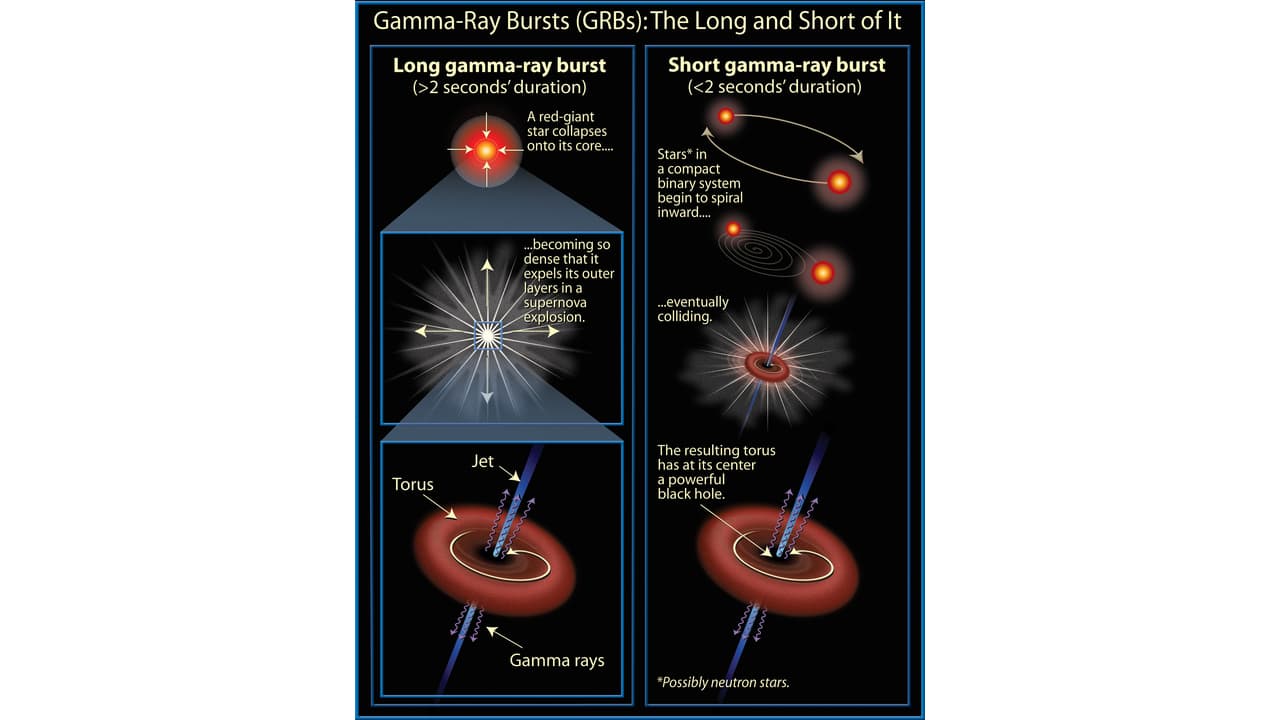What’s in today’s article?
- Why in News?
- About GBR
- Significance of the latest finding
- About DOT
Why in News?
- A team of scientists has recorded a once-in-a-lifetime astronomical occurrence including a compact binary merger emitting long duration Gamma Ray Burst (GRB) coupled with kilonova emissions – a never-before scientifically acknowledged or proved combination.
- The 3.6-metre Devasthal Optical Telescope (DOT), maintained by Aryabhatta Research Institute of Observational Sciences (ARIES), Nainital, was one of the key global telescopes that validated this rare combination.
The Gamma Ray Bursts (GRBs):
- Background of Gamma Ray Bursts
Image Caption: Long and short gamma ray bursts
- When a pair of binary compact systems – either two blackholes, dense celestial bodies or neutron stars, rotate in a spiral fashion for billions of years, their ultimate merger leads to release of short GRBs, which last for less than 2 seconds.
- Traditionally, kilonova – the radiation emerging from the merger of neutron stars or any other binary systems, has been associated with short GRBs.
- On the other hand, when very massive stars die, the event results in the release of long GRBs and the associated gamma radiations last for more than 2 seconds or longer.
- About GBRs:
- They are massive but extremely bright, high-energy short gamma radiations which get released when massive stars collapse or die in the Universe.
- The energy associated with GRBs is many folds larger than what Sun can emit in its entire lifetime, making its study key to understanding the life and death of stars in the Universe.
- What is unique about the latest finding?
- The burst of high energy light identified as GRB211211A lasted for over 50 seconds and appeared nearby in the outskirts of the Milky Way – some one billion light years away.
- However, the properties of long duration GRB were missing, making the event unusual.
What is the significance of the recent scientific finding?
- Scientists have, so far, associated short GRBs with supernovae (the explosion of a massive star).
- However, the latest study has called into question the previous theory, as scientists were unaware of any link between a long duration GRB and kilonovae.
- This could then mean that some processes are common between the long and short GRBs and their scientific classification now stands challenged.
About the Devasthal Optical Telescope (DOT):
- The telescope, installed at Devasthal, Nainital, Uttarakhand, has the distinction of being the largest telescope in India for study of celestial objects at optical wavelengths.
- It was commissioned in the year 2016 and is being maintained and operated by ARIES.
- It consists of a modern 6-meter optical new technology telescope and enjoys the longitudinal advantage which facilitated the viewing of the events like the present one.
Q1) What is bigger kilonova or supernova?
Supernova explosions are far bigger than those produced by a kilonova explosion due to the former ejecting more energy than the latter.
Q2) What happens if a gamma-ray burst hit Earth?
A GRB would deplete the ozone layer in the upper atmosphere, allowing harmful UV radiation to reach the ground and thus have dire consequences for life. However, the ground-level ozone caused by the GRB would not be an additional hazard for life
Last updated on December, 2025
→ Check out the latest UPSC Syllabus 2026 here.
→ Join Vajiram & Ravi’s Interview Guidance Programme for expert help to crack your final UPSC stage.
→ UPSC Mains Result 2025 is now out.
→ UPSC Notification 2026 is scheduled to be released on January 14, 2026.
→ UPSC Calendar 2026 is released on 15th May, 2025.
→ The UPSC Vacancy 2025 were released 1129, out of which 979 were for UPSC CSE and remaining 150 are for UPSC IFoS.
→ UPSC Prelims 2026 will be conducted on 24th May, 2026 & UPSC Mains 2026 will be conducted on 21st August 2026.
→ The UPSC Selection Process is of 3 stages-Prelims, Mains and Interview.
→ UPSC Result 2024 is released with latest UPSC Marksheet 2024. Check Now!
→ UPSC Prelims Result 2025 is out now for the CSE held on 25 May 2025.
→ UPSC Toppers List 2024 is released now. Shakti Dubey is UPSC AIR 1 2024 Topper.
→ UPSC Prelims Question Paper 2025 and Unofficial Prelims Answer Key 2025 are available now.
→ UPSC Mains Question Paper 2025 is out for Essay, GS 1, 2, 3 & GS 4.
→ UPSC Mains Indian Language Question Paper 2025 is now out.
→ UPSC Mains Optional Question Paper 2025 is now out.
→ Also check Best IAS Coaching in Delhi

















